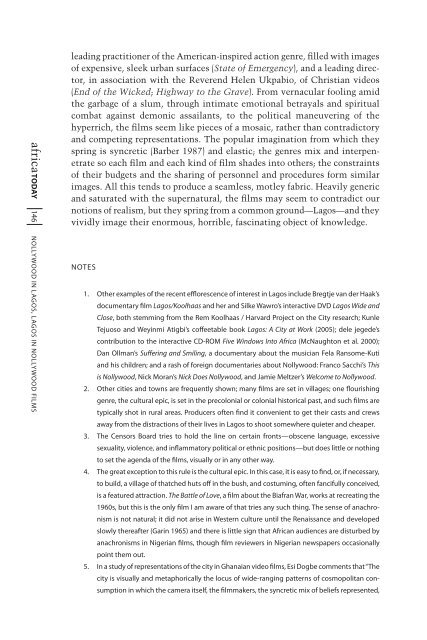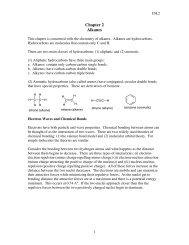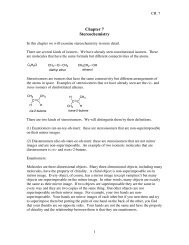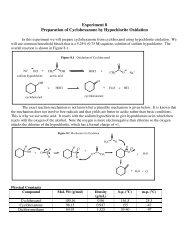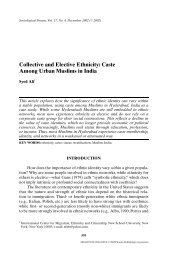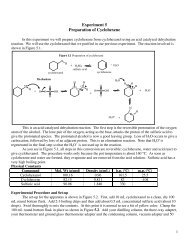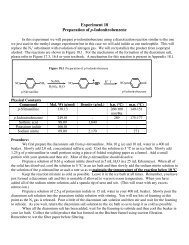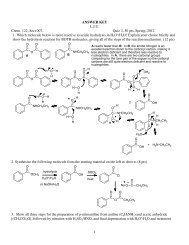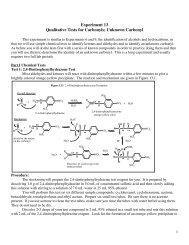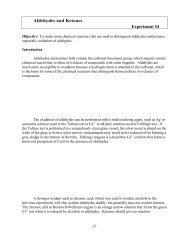Lagos is the ground of the films, not just in the sense that ... - myweb
Lagos is the ground of the films, not just in the sense that ... - myweb
Lagos is the ground of the films, not just in the sense that ... - myweb
You also want an ePaper? Increase the reach of your titles
YUMPU automatically turns print PDFs into web optimized ePapers that Google loves.
africa today 146 Nollywood <strong>in</strong> <strong>Lagos</strong>, <strong>Lagos</strong> <strong>in</strong> Nollywood Filmslead<strong>in</strong>g practitioner <strong>of</strong> <strong>the</strong> American-<strong>in</strong>spired action genre, filled with images<strong>of</strong> expensive, sleek urban surfaces (State <strong>of</strong> Emergency), and a lead<strong>in</strong>g director,<strong>in</strong> association with <strong>the</strong> Reverend Helen Ukpabio, <strong>of</strong> Chr<strong>is</strong>tian videos(End <strong>of</strong> <strong>the</strong> Wicked; Highway to <strong>the</strong> Grave). From vernacular fool<strong>in</strong>g amid<strong>the</strong> garbage <strong>of</strong> a slum, through <strong>in</strong>timate emotional betrayals and spiritualcombat aga<strong>in</strong>st demonic assailants, to <strong>the</strong> political maneuver<strong>in</strong>g <strong>of</strong> <strong>the</strong>hyperrich, <strong>the</strong> <strong>films</strong> seem like pieces <strong>of</strong> a mosaic, ra<strong>the</strong>r than contradictoryand compet<strong>in</strong>g representations. The popular imag<strong>in</strong>ation from which <strong>the</strong>yspr<strong>in</strong>g <strong>is</strong> syncretic (Barber 1987) and elastic; <strong>the</strong> genres mix and <strong>in</strong>terpenetrateso each film and each k<strong>in</strong>d <strong>of</strong> film shades <strong>in</strong>to o<strong>the</strong>rs; <strong>the</strong> constra<strong>in</strong>ts<strong>of</strong> <strong>the</strong>ir budgets and <strong>the</strong> shar<strong>in</strong>g <strong>of</strong> personnel and procedures form similarimages. All th<strong>is</strong> tends to produce a seamless, motley fabric. Heavily genericand saturated with <strong>the</strong> supernatural, <strong>the</strong> <strong>films</strong> may seem to contradict our<strong>not</strong>ions <strong>of</strong> real<strong>is</strong>m, but <strong>the</strong>y spr<strong>in</strong>g from a common <strong>ground</strong>—<strong>Lagos</strong>—and <strong>the</strong>yvividly image <strong>the</strong>ir enormous, horrible, fasc<strong>in</strong>at<strong>in</strong>g object <strong>of</strong> knowledge.Notes1. O<strong>the</strong>r examples <strong>of</strong> <strong>the</strong> recent efflorescence <strong>of</strong> <strong>in</strong>terest <strong>in</strong> <strong>Lagos</strong> <strong>in</strong>clude Bregtje van der Haak’sdocumentary film <strong>Lagos</strong>/Koolhaas and her and Silke Wawro’s <strong>in</strong>teractive DVD <strong>Lagos</strong> Wide andClose, both stemm<strong>in</strong>g from <strong>the</strong> Rem Koolhaas / Harvard Project on <strong>the</strong> City research; KunleTejuoso and Wey<strong>in</strong>mi Atigbi’s c<strong>of</strong>feetable book <strong>Lagos</strong>: A City at Work (2005); dele jegede’scontribution to <strong>the</strong> <strong>in</strong>teractive CD-ROM Five W<strong>in</strong>dows Into Africa (McNaughton et al. 2000);Dan Ollman’s Suffer<strong>in</strong>g and Smil<strong>in</strong>g, a documentary about <strong>the</strong> musician Fela Ransome-Kutiand h<strong>is</strong> children; and a rash <strong>of</strong> foreign documentaries about Nollywood: Franco Sacchi’s Th<strong>is</strong><strong>is</strong> Nollywood, Nick Moran’s Nick Does Nollywood, and Jamie Meltzer’s Welcome to Nollywood.2. O<strong>the</strong>r cities and towns are frequently shown; many <strong>films</strong> are set <strong>in</strong> villages; one flour<strong>is</strong>h<strong>in</strong>ggenre, <strong>the</strong> cultural epic, <strong>is</strong> set <strong>in</strong> <strong>the</strong> precolonial or colonial h<strong>is</strong>torical past, and such <strong>films</strong> aretypically shot <strong>in</strong> rural areas. Producers <strong>of</strong>ten f<strong>in</strong>d it convenient to get <strong>the</strong>ir casts and crewsaway from <strong>the</strong> d<strong>is</strong>tractions <strong>of</strong> <strong>the</strong>ir lives <strong>in</strong> <strong>Lagos</strong> to shoot somewhere quieter and cheaper.3. The Censors Board tries to hold <strong>the</strong> l<strong>in</strong>e on certa<strong>in</strong> fronts—obscene language, excessivesexuality, violence, and <strong>in</strong>flammatory political or ethnic positions—but does little or <strong>not</strong>h<strong>in</strong>gto set <strong>the</strong> agenda <strong>of</strong> <strong>the</strong> <strong>films</strong>, v<strong>is</strong>ually or <strong>in</strong> any o<strong>the</strong>r way.4. The great exception to th<strong>is</strong> rule <strong>is</strong> <strong>the</strong> cultural epic. In th<strong>is</strong> case, it <strong>is</strong> easy to f<strong>in</strong>d, or, if necessary,to build, a village <strong>of</strong> <strong>that</strong>ched huts <strong>of</strong>f <strong>in</strong> <strong>the</strong> bush, and costum<strong>in</strong>g, <strong>of</strong>ten fancifully conceived,<strong>is</strong> a featured attraction. The Battle <strong>of</strong> Love, a film about <strong>the</strong> Biafran War, works at recreat<strong>in</strong>g <strong>the</strong>1960s, but th<strong>is</strong> <strong>is</strong> <strong>the</strong> only film I am aware <strong>of</strong> <strong>that</strong> tries any such th<strong>in</strong>g. The <strong>sense</strong> <strong>of</strong> anachron<strong>is</strong>m<strong>is</strong> <strong>not</strong> natural; it did <strong>not</strong> ar<strong>is</strong>e <strong>in</strong> Western culture until <strong>the</strong> Rena<strong>is</strong>sance and developedslowly <strong>the</strong>reafter (Gar<strong>in</strong> 1965) and <strong>the</strong>re <strong>is</strong> little sign <strong>that</strong> African audiences are d<strong>is</strong>turbed byanachron<strong>is</strong>ms <strong>in</strong> Nigerian <strong>films</strong>, though film reviewers <strong>in</strong> Nigerian newspapers occasionallypo<strong>in</strong>t <strong>the</strong>m out.5. In a study <strong>of</strong> representations <strong>of</strong> <strong>the</strong> city <strong>in</strong> Ghanaian video <strong>films</strong>, Esi Dogbe comments <strong>that</strong> “Thecity <strong>is</strong> v<strong>is</strong>ually and metaphorically <strong>the</strong> locus <strong>of</strong> wide-rang<strong>in</strong>g patterns <strong>of</strong> cosmopolitan consumption<strong>in</strong> which <strong>the</strong> camera itself, <strong>the</strong> filmmakers, <strong>the</strong> syncretic mix <strong>of</strong> beliefs represented,


